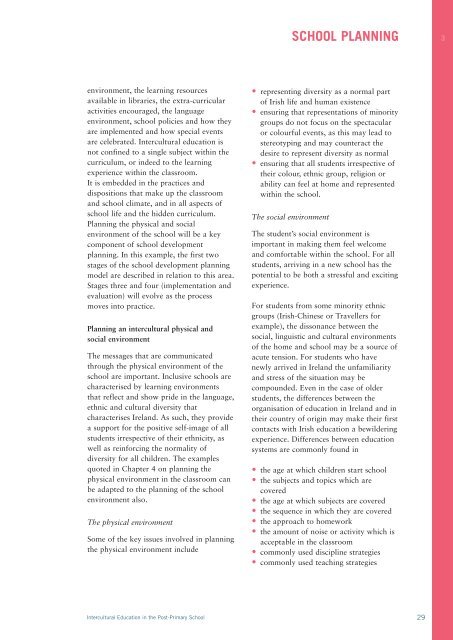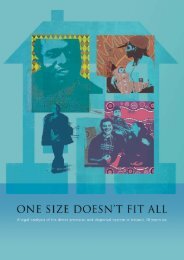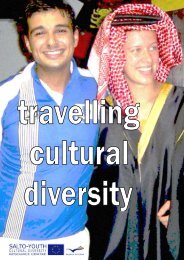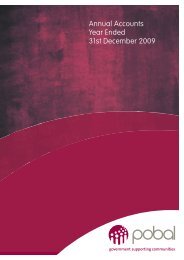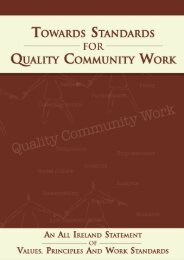Intercultural Education in the Post-Primary School - National Council ...
Intercultural Education in the Post-Primary School - National Council ...
Intercultural Education in the Post-Primary School - National Council ...
You also want an ePaper? Increase the reach of your titles
YUMPU automatically turns print PDFs into web optimized ePapers that Google loves.
SCHOOL PLANNING 3environment, <strong>the</strong> learn<strong>in</strong>g resourcesavailable <strong>in</strong> libraries, <strong>the</strong> extra-curricularactivities encouraged, <strong>the</strong> languageenvironment, school policies and how <strong>the</strong>yare implemented and how special eventsare celebrated. <strong>Intercultural</strong> education isnot conf<strong>in</strong>ed to a s<strong>in</strong>gle subject with<strong>in</strong> <strong>the</strong>curriculum, or <strong>in</strong>deed to <strong>the</strong> learn<strong>in</strong>gexperience with<strong>in</strong> <strong>the</strong> classroom.It is embedded <strong>in</strong> <strong>the</strong> practices anddispositions that make up <strong>the</strong> classroomand school climate, and <strong>in</strong> all aspects ofschool life and <strong>the</strong> hidden curriculum.Plann<strong>in</strong>g <strong>the</strong> physical and socialenvironment of <strong>the</strong> school will be a keycomponent of school developmentplann<strong>in</strong>g. In this example, <strong>the</strong> first twostages of <strong>the</strong> school development plann<strong>in</strong>gmodel are described <strong>in</strong> relation to this area.Stages three and four (implementation andevaluation) will evolve as <strong>the</strong> processmoves <strong>in</strong>to practice.Plann<strong>in</strong>g an <strong>in</strong>tercultural physical andsocial environmentThe messages that are communicatedthrough <strong>the</strong> physical environment of <strong>the</strong>school are important. Inclusive schools arecharacterised by learn<strong>in</strong>g environmentsthat reflect and show pride <strong>in</strong> <strong>the</strong> language,ethnic and cultural diversity thatcharacterises Ireland. As such, <strong>the</strong>y providea support for <strong>the</strong> positive self-image of allstudents irrespective of <strong>the</strong>ir ethnicity, aswell as re<strong>in</strong>forc<strong>in</strong>g <strong>the</strong> normality ofdiversity for all children. The examplesquoted <strong>in</strong> Chapter 4 on plann<strong>in</strong>g <strong>the</strong>physical environment <strong>in</strong> <strong>the</strong> classroom canbe adapted to <strong>the</strong> plann<strong>in</strong>g of <strong>the</strong> schoolenvironment also.The physical environmentSome of <strong>the</strong> key issues <strong>in</strong>volved <strong>in</strong> plann<strong>in</strong>g<strong>the</strong> physical environment <strong>in</strong>clude• represent<strong>in</strong>g diversity as a normal partof Irish life and human existence• ensur<strong>in</strong>g that representations of m<strong>in</strong>oritygroups do not focus on <strong>the</strong> spectacularor colourful events, as this may lead tostereotyp<strong>in</strong>g and may counteract <strong>the</strong>desire to represent diversity as normal• ensur<strong>in</strong>g that all students irrespective of<strong>the</strong>ir colour, ethnic group, religion orability can feel at home and representedwith<strong>in</strong> <strong>the</strong> school.The social environmentThe student’s social environment isimportant <strong>in</strong> mak<strong>in</strong>g <strong>the</strong>m feel welcomeand comfortable with<strong>in</strong> <strong>the</strong> school. For allstudents, arriv<strong>in</strong>g <strong>in</strong> a new school has <strong>the</strong>potential to be both a stressful and excit<strong>in</strong>gexperience.For students from some m<strong>in</strong>ority ethnicgroups (Irish-Ch<strong>in</strong>ese or Travellers forexample), <strong>the</strong> dissonance between <strong>the</strong>social, l<strong>in</strong>guistic and cultural environmentsof <strong>the</strong> home and school may be a source ofacute tension. For students who havenewly arrived <strong>in</strong> Ireland <strong>the</strong> unfamiliarityand stress of <strong>the</strong> situation may becompounded. Even <strong>in</strong> <strong>the</strong> case of olderstudents, <strong>the</strong> differences between <strong>the</strong>organisation of education <strong>in</strong> Ireland and <strong>in</strong><strong>the</strong>ir country of orig<strong>in</strong> may make <strong>the</strong>ir firstcontacts with Irish education a bewilder<strong>in</strong>gexperience. Differences between educationsystems are commonly found <strong>in</strong>• <strong>the</strong> age at which children start school• <strong>the</strong> subjects and topics which arecovered• <strong>the</strong> age at which subjects are covered• <strong>the</strong> sequence <strong>in</strong> which <strong>the</strong>y are covered• <strong>the</strong> approach to homework• <strong>the</strong> amount of noise or activity which isacceptable <strong>in</strong> <strong>the</strong> classroom• commonly used discipl<strong>in</strong>e strategies• commonly used teach<strong>in</strong>g strategies<strong>Intercultural</strong> <strong>Education</strong> <strong>in</strong> <strong>the</strong> <strong>Post</strong>-<strong>Primary</strong> <strong>School</strong> 29


